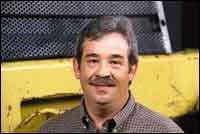We target 70 percent utilization for the equipment we own and adjust the fleet size accordingly," says John Sharp, equipment support manager with Blythe Construction. In two years, the number of machines in the fleet has been reduced by 45 percent and owning costs have dropped by 40 percent.
Sharp has worked toward the 70-percent utilization goal together with Steve Burleyson, Blythe's construction services manager, and Bill White, service manager, under the direction of the vice president of the equipment division, Bruce Prentice. The number of rented machines, relative to owned equipment, has increased sharply as Burleyson and White have trimmed heavier elements of the construction fleet. They've reduced heavy-equipment units by 30 percent, replacing about half of them with rentals.
The number of units in the small-equipment portion of the fleet (Sharp's primary responsibility) has been cut by half. At times of peak demand, Blythe will have about 425 of these units in the field. Small equipment includes not only such items as skid-steer loaders, compressors, light plants, and compaction tools, but also field offices and storage systems, solar traffic control devices, trench shields and power tools.
Half of the reduction in small equipment was simply elimination of excess inventory. Blythe might have kept the other half, if not for the raised utilization standard. Small-equipment rentals have climbed from supplying 5 percent of Blythe's total demand two years ago to roughly 25 percent now.
"We estimate the number may increase to nearly 50 percent," says Sharp.
"Virtually every class of equipment that we can readily rent will be adjusted to favor a smaller core fleet, using rentals to supply peak demand," Sharp says.
Blythe's management system from J.D. Edwards generates weekly equipment-cost reports on both rented and owned machines. Sharp and the other equipment-department leaders use the reports to monitor utilization of company-owned equipment and to be sure rented machines are not languishing on jobsites.
They manage average utilization by machine category. One-hundred-percent utilization would be 2,080 hours per year—52 weeks at 40 hours per week. If the average of all the machines in a category drops below 70 percent for the previous rolling 12-month period, it draws an investigation.
If the situation suggests there are too many machines in the category, the management team will check machine demand expected in the coming 12 months. Depending on reliability of individual units and expected demand, underutilized machines can either be reassigned or moved out of the fleet. Of course, there are some low-utilization units that can't be easily rented. Nevertheless, fleet-wide utilization has climbed significantly.
Rising utilization drives hourly ownership and operating costs down. Culling the least reliable machines is reducing maintenance and repair costs. Increasing rental business is improving rental costs. As they work with vendors to streamline the rental process, they agree up front on service expectations and rates acceptable to both parties.
"We try to forge partnerships with our vendors," Sharp says. "I will promise to give them all the business I can—they get the first call—as long as they continue to supply our needs and we can work together to reduce each others' costs.
"We look for vendors that are willing to think outside the box—to be proactive with their approach to cost reduction in their own fleets and who can recommend ways that we can reduce costs in our operations," Sharp says. "We look at rates and we look at the value-added things they can do. For example, we ask vendors to send us a monthly bill summary—one that includes our internal account codes so we can quickly check to see that all the invoices and dates are correct. It saves time and reduces overhead for us.
"We're going to start doing electronic billing with RSC," Sharp adds. "We're not quite there yet, but when we do get the list electronically, I can review it and make corrections electronically, and we'll be able to pay the invoice as well as debit our internal cost code, which will eliminate redundant keypunch time."
Blythe rents most of its small equipment from RSC. Larger machines come from the rental operations of local equipment dealers—Carolina Tractor, Mitchell Distributing and Briggs Equipment.
"We are able to avoid duplicating the overhead that the rental companies have in place to support these machines," Sharp says. "If we don't need the machines for high-production work, there's no reason for us to carry year-round overhead to support them."




